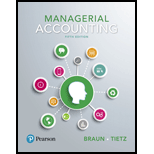
Concept explainers
Comprehensive ABC (Learning Objectives 2 & 3)
FirstServer Systems specializes in servers for work-group, e-commerce, and enterprise resource planning (ERP) applications. The company’s original
A task force headed by FirstServer’s CFO recently designed an ABC system with four activities. The ABC system retains the current system s two direct cost categories. Thus, it budgets only overhead costs for each activity. Pertinent data follow:
| Activity | Allocation Base | Cost Allocation Rate |
| Materials handling | Number of parts | $ 1 10 |
| Machine setup | Number of setups | $ 500.00 |
| Assembling | Assembling hours | $ 80 00 |
| Shipping | Number of shipments | $1,700.00 |
FirstServer Systems has been awarded two new contracts that will be produced as Job A and Job B. Budget data relating to the contracts follow:
| Job A | Job B | |
| Number of parts | 10,000 | 2,000 |
| Number of setups | 20 | 8 |
| Number of assembling hours | 1,000 | 200 |
| Number of shipments | 1 | 1 |
| Total direct labor hours | 9,200 | 500 |
| Number of output units | 100 | 10 |
| Direct materials cost | $246,000 | $46,900 |
| Direct labor cost | $180,000 | $18,000 |
Requirements
- 1. Compute the product cost per unit for each job using the original costing system (with two direct cost categories and a single overhead allocation rate).
- 2. Suppose FirstServer Systems adopts the ABC system. Compute the product cost per unit for each job using ABC.
- 3. Which costing system more accurately assigns to jobs the costs of the resources consumed to produce them? Explain.
- 4. A dependable company has offered to produce both jobs for FirstServer for $5,600 per output unit. FirstServer may outsource (buy from the outside company) Job A only. Job B only, or both jobs. Which course of action will FirstServer managers take if they base their decision on (a) the original system? (b) ABC system costs? Which course of action will yield more income? Explain.
Want to see the full answer?
Check out a sample textbook solution
Chapter 4 Solutions
Managerial Accounting, Student Value Edition (5th Edition)
- Satish Sales Company had a gross profit margin (gross profits/sales) of 27% and sales of $10.2 million last year. 78% of the firm's sales are on credit, and the remainder are cash sales. Satish's current assets total $1.6 million, its current liabilities total $310,000, and it has $120,000 in cash plus marketable securities. (a) If Satish's accounts receivable equal $610,500, what is its average collection period? (b) If Satish reduces its average collection period to 22 days, what will be its new level of accounts receivable?arrow_forwardWhat is the Equity of this financial accounting question?arrow_forwardWhat is the contribution margin per unit sold? Accounting questionarrow_forward
 Cornerstones of Cost Management (Cornerstones Ser...AccountingISBN:9781305970663Author:Don R. Hansen, Maryanne M. MowenPublisher:Cengage Learning
Cornerstones of Cost Management (Cornerstones Ser...AccountingISBN:9781305970663Author:Don R. Hansen, Maryanne M. MowenPublisher:Cengage Learning Managerial AccountingAccountingISBN:9781337912020Author:Carl Warren, Ph.d. Cma William B. TaylerPublisher:South-Western College Pub
Managerial AccountingAccountingISBN:9781337912020Author:Carl Warren, Ph.d. Cma William B. TaylerPublisher:South-Western College Pub Financial And Managerial AccountingAccountingISBN:9781337902663Author:WARREN, Carl S.Publisher:Cengage Learning,
Financial And Managerial AccountingAccountingISBN:9781337902663Author:WARREN, Carl S.Publisher:Cengage Learning,


